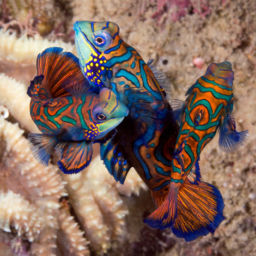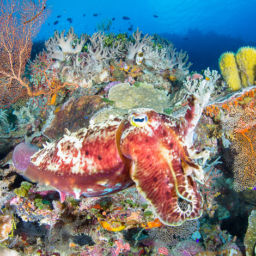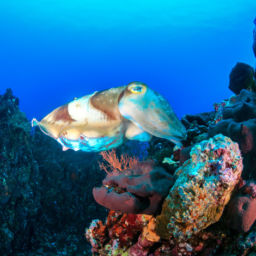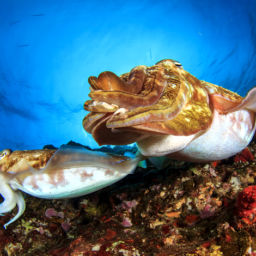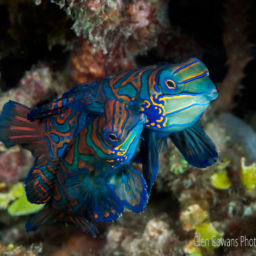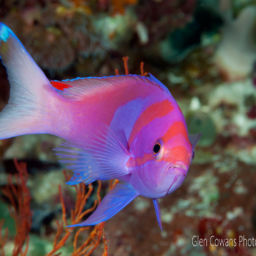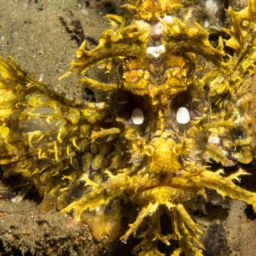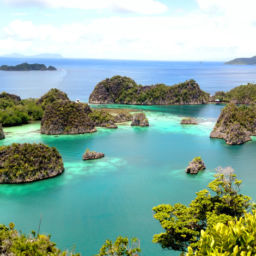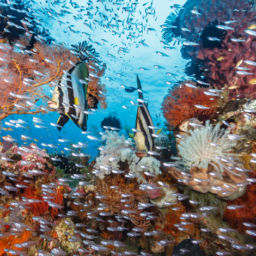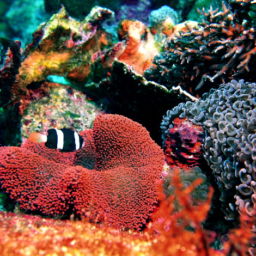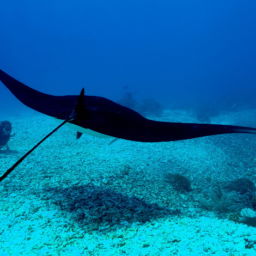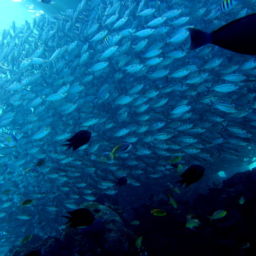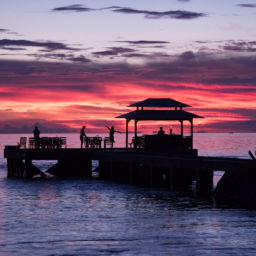Dedicated divers know that a liveaboard is the best way to dive as much as possible. Your moving hotel deposits you somewhere new nearly every day, just minutes from the next dive site. After 11 days onboard Damai II, visiting Alor and Komodo, you might think that my dive companions and I would be ready for dry land. But the luxury and comfort of the boat, combined with the stellar diving, just left us hungry for more.
Alor and Komodo are legendary destinations in dive circles, offering everything from healthy reefs and muck diving, as well as epic encounters with manta rays and whale sharks. Since there’s a lot of ocean to cover between Alor and Komodo, we made the Damai II — or Damai Dua as it’s called — our chariot of choice. Dive Damai has two vessels, Damai I and Damai II, and a variety of Indonesian itineraries.
To begin our trip, we flew from Bali to Maumere, the largest town on the island of Flores. After airport pickup, we headed straight to the boat with two other passengers. The other diver on board, 82-year-old Mary Jane, was on her second back-to-back cruise. (If I dive half as much at that age, I’ll be thrilled). When we pulled up to the end of the dock in Maumere, we could see the Damai Dua floating in the distance. Meaning “peace” in Bahasa Indonesian, the 131-foot (40 m) Damai II glowed in the afternoon light. We couldn’t wait to get onboard.
The Damai II
Elegant without being fussy, the Damai II offers spot-on boutique diving. Built in southwest Sulawesi, the phinisi is a traditional Indonesian two-masted sailboat, constructed mostly of teak. It took two years to finish, with completion in 2011. Attention to detail is apparent everywhere you look. With three areas for lounging, I laid claim to one of the top deck’s beanbags early on.
The indoor lounge area offers a large, u-shaped couch, strewn with comfy pillows. On the other side of an open wall, decorated with wooden sculptures of seashells, is the family-style dining area, which encourages guests to interact with each other. Our first order of business was meeting the 19 staff members on board. With only six guests on our cruise, we had particularly personalized service.
After introductions were complete, we headed downstairs to check out our cabins. The boat has seven rooms in total — five downstairs and two upstairs, sleeping a maximum of 12 guests. My room, all polished teak and warm wood floors, had a comfy double bed and a day bed, a flat-screen TV (that I never turned on), air conditioning, and a roomy shower with seemingly endless hot water.
Diving from the Damai II
When it comes to diving, the Damai II maintains a maximum ratio of four guests to one dive guide. One of our travel companions (the inimitable Mary Jane) had a private guide, so with five of us left, my two companions and I had one guide while the other two guests had one as well. All three guides — Salim, Anton and Yanto — have hundreds of combined dives trips on the Damai II. We could not have been in better hands.
The dive deck occupies the front third of the boat on the main level. Each guest has a drawer and small shelf, as well as a rinsing tub to toss small things in between dives. There are also hot outdoor showers and a rinse tub for wetsuits and BCDs (which we never got near, as the dive guides took care of pretty much everything). Our two cruise directors held dive briefings at the front of the dive deck, drawing maps of each site and pointing us to the appropriate tender (there are two) when it was time to hop in.
Both my dive buddies are photographers, so their next stop was the camera room. With plenty of space and charging stations, they both seemed satisfied. I continued my exploration on the top deck, where I found the aforementioned beanbag chair. This would become my chosen perch for the entire cruise. As we pulled away from the harbor at Maumere, it was time to get ready for our checkout dive before our first official destination: Alor.
Diving Alor
Although there’s a set route, it’s partially up to the currents, tides, guests and cruise director to decide where and when you’ll dive. There are four dives per day — three daytime dives and one night dive. Dives range from sandy critter-hunting macro sites to coral slopes and walls and ripping currents through channels. Our checkout dive was just outside the Maumere harbor at a small island called Pomana Kecil.
Even though my mask fogged for the entire dive (note to self: if you’re diving with a new mask, don’t forget the toothpaste treatment), it was nonetheless an auspicious start. We spotted a pygmy seahorse almost immediately. Our dive guides took care of everything from the first dive on, transporting our gear back and forth to the tender, setting up our next tanks, and rinsing between dives. After the check dive, we began motoring to our first destination: The Alor Archipelago.
We spent the next four days heading east, exploring sites such as Solor, Adonara, Pantar, Pura and Lembata. The sites were as exotic as the island names would imply: Pulau Kambing, Tanjung Wotang, Baeangabang, Valley of the Clowns. My notes about each site piled on the superlatives — amazing, incredible, my favorite dive — over and over. Although I’ll talk more about the diving in another article, a few favorites merit multiple mentions: Valley of the Clowns and Anak Anak Alor.
The former, a nearshore, shallow dive is thusly named because divers drop in over an endless carpet of anemones in all shapes and sizes, swaying hypnotically in the surge. Although many of the anemones are unoccupied, many feature the ever-popular and ever-territorial anemonefish. Looking out over the scene, we saw countless numbers of these photogenic little fish, all hovering protectively over their anemone home.
Anak Anak Alor offered an entirely different kind of experience. When they see the boat coming, kids from Tola Bali village wait for the divers to come in to shallow-water coral. The kids jump in and dive underwater, mugging for the divers’ cameras. On our visit, there were 72 kids, hamming it up with us in about 20 feet of water. Most wore homemade googles with soda bottle bottoms for lenses, if any.
Diving Komodo
After Alor, we headed back west past Flores, and toward perhaps the most famous of all dive destinations: Komodo National Park. We arrived on day six of our journey, and jumped in right away on a site called Sebolan Kecil. A sleeping shark and blue-spotted stingray greeted us there, but the best was yet to come. Batu Bolong, a small, rocky pinnacle in the main channel was a highlight of the trip. After an intense dive briefing, warning that the site can feature a nasty downcurrent, I was ready for anything. The cruise director told us to stay right behind our guides, and here I’ve got to offer apologies to Yanto, who could barely fin as I was stuck so closely behind him.
After we splashed in, it was clear right away that the dive would be worth the extra precautions. Swept as it is by constant currents, the site is positively bursting with life. Wildly waving soft corals, riotously colored hard corals, and schools of anthias and blue tangs all swirled about. Manta rays, sharks, reef fish and the biggest hawksbill turtle I’ve ever seen all stopped by during our 60-minute dive. We zig-zagged back and forth, climbing from 95 feet up to 15 for our safety stop, and I watched Yanto almost as much as the fish life.
Glorious sites kept coming in Komodo, one after the other — Castle Rock, Crystal Rock, and Taka Makassar, my best manta dive ever. There was so much to see in Komodo that it would be impossible to summarize here; instead we’ll cover sites in more depth in a forthcoming story. Our Komodo trip ended in Horseshoe Bay, where we motored in to get a closer look at the eponymous Komodo dragons. Although they appear slow and lumbering, we received a similarly intense briefing about their running capabilities and toxicity of their bite, so some of us (ahem) elected to view these magnificent creatures from the confines of the boat.
Eat, Sleep, Dive
It would be remiss to get this far in any story about a liveaboard without mentioning the food. There are really only three main activities on a liveaboard: eating, sleeping and diving. Which suited us just fine. The kitchen staff kept us more than well-fed. First breakfast consisted of fruit, yogurt, granola and the like, followed by a second hot breakfast after our dive. Lunch and dinner were made to order. Entrees ranged from nasi goreng to gado gado (vegetables in peanut sauce) and spaghetti Bolognese. Each night featured a veggie-based soup and a delicious dessert. If death by chocolate is how I go, fine by me.
On one of our last nights on board, we dined on the top deck, overlooking the green hills of Komodo as we rocked gently on the waves. With fairy lights strung on the mast and our ever-attentive bartender and steward Ketut seeing to it that our wine glasses were never less than half full, we reflected on our trip. We’d seen everything from the tiniest pygmy seahorses to giant manta rays. We’d been muck diving and diving with kids, diving on walls, and in soft-coral gardens. It would be impossible to match the variety of sites we visited onboard the Damai II. And were we ready to head back to dry land after those 11 glorious days? Not a chance — we’re already planning our next trip.
The Details
With seven total rooms, the boat sleeps 12 guests. Cruises run from seven to about 15 days, mostly spanning 11 or 12 days like ours.
How to get there: Cruises run from a number of locations, depending on the itinerary. Fly into a hub, such as Bali or Jakarta, and catch the domestic flight from there. Komodo-specific cruises generally depart from Labuan Bajo, while Komodo/Alor trips usually begin in Maumere and end in Labuan Bajo. To make booking easier, Dive Damai’s concierge team can arrange domestic flights, with a 15 percent administration and sales tax charge on top of the flight price. Check here for available 2017 cruises.
When to go:
Dive conditions can vary depending on your destination and the time of year. Visibility can range from 16 to 130-plus feet (5 to 40-plus meters). Water temps can vary from 86 to 65 F (30 C to 17C), with cooler temperatures in southern Komodo. A 3 mm wetsuit will be sufficient for most dives, though you may want a hooded vest to wear overtop for the chillier waters.
Currents are par for the course in Indonesia, and you can expect to find them year-round. Dive guides always check the current prior to the group splashing in, and if it’s too intense, you’ll head to another site. If a dive site does feature current there’s likely a lot of life, so follow your dive guide’s instructions and trust their judgement.
What to bring:
Dive insurance is compulsory for every Damai II trip, and the company offers free DAN AP insurance. If you’d like to dive nitrox, preferable due to the number of dives per day, bring your certification card for that as well. If you’re not yet nitrox certified, you can take a short training course on board the boat for an extra fee.
As for gear, most divers bring their own, although the boat does have limited rental gear. Bathrooms in the cabins feature basic toiletries, and all are palm oil and sulphate free.















